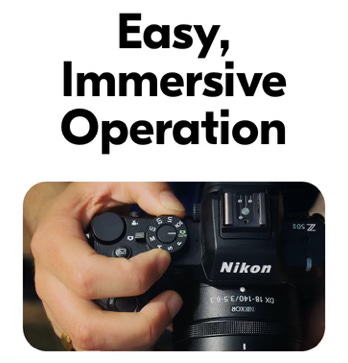Nikon’s new Z50II camera, bristling with buttons and dials and switches, boasts “easy, immersive operation.” I understand why an entry-level camera would be advertised as “easy,” but “immersive”? (I’m no marketing expert, but wouldn’t “intuitive” have been a better choice?)
Does Nikon really mean to suggest that operating this camera (rather than, say, viewing the 21 megapixel image it produces) is an immersive experience? In other words, you’ll be so busy with all those controls and settings and options and adjustments that you’ll forget about the bit of reality you wanted to take a picture of?
According to the specs, the camera’s vaunted “operation” consists of features like “scene modes,” customizable controls, a “versatile touchscreen,” long exposures, and a “bright, immersive viewfinder”:
With the Nikon Z50II’s viewfinder, you can see the world clearly and shoot confidently—even in bright conditions. The Z50II allows you to stay focused on the moment without distraction, capturing and connecting seamlessly.
See the world clearly. Stay focused. Capture and connect. No seams! (Maybe what Nikon means by “immersive” is “seamless”?)
The original sense of the word immersive—“characterized by or involving [literal] immersion”—dates from the early 1600s, according to the OED. Then in the 20th century, immersive acquired additional meanings that specifically apply to the ability of art, theater, and technology (especially virtual or augmented reality) to “surround” and/or “fully engage” us. Merriam-Webster’s definition covers most of this territory: immersive means “providing, involving, or characterized by deep absorption or immersion in something (such as an activity or a real or artificial environment).”
I’ve been seeing the word immersive a lot lately. Sometimes it makes sense, as in this description of Apple’s AirPods 4: “These small but mighty Apple earbuds offer an immersive sound experience thanks to their active noise-cancellation technology, which can drown out traffic, chatter, and other external disturbances.”
“In an immersive experience,” says Catherine Garcia in The Week, “the boundaries blur … your senses get overtaken and you are no longer a witness but a participant.” You “lose yourself” in the art or game or other spectacle.
Production company Emursive’s Life and Trust, for example, is described by the New York Times (gift link) as an “immersive piece of theater” that “transports visitors to the Gilded Age through a retrofitted skyscraper in Manhattan.” Audience members wear masks and “wander the sprawling 100,000-square-foot space” while performers act out 250 overlapping scenes that “loop twice during the evening.”
In an immersive twist on dinner theater, London’s Murdér Express [sic]1 “starts with guests boarding a train in the fictional Pedley Street Station and quickly escalates to someone getting murdered and the rest of the group needing to figure out whodunit.” Reviews praise the “commitment to detail.” Screens at each table “showing country scenery make it feel like you really are heading somewhere.”
An immersive experience is so absorbing that it replaces reality. That’s what you want from, say, a flight simulator or a sensory deprivation tank.
Not surprisingly, the word immersive comes up frequently in the context of 360-degree “action cameras” (like the GoPro), which offer a way to convert real-life experience into “immersive” video. According to the 360 Rumors website, “360 videos provide a uniquely immersive and candid view.”

Art can also be immersive. But for exhibit purposes, immersiveness seems mostly to consist of saturating the space and the viewer with really big (projected) art. Van Gogh in particular has been the subject of a veritable “wave” of immersive art installations (in 2021, Bloomberg counted “nearly 40” in the U.S. alone).
Such exhibits promise that becoming a participant in the spectacle will give you a fuller experience of the art. A huge image of a Van Gogh painting projected on the walls, the floor, and the exhibit-goers around me would certainly make me feel surrounded (and possibly seasick). But I can’t believe I would experience any greater engagement with the work itself than if I had been left alone to contemplate the actual painting hanging quietly on a wall.
Maybe I’m turned off by immersive art exhibits because they seem to be encouraging the opposite of attention: After all, you can’t really see the painting if it’s all over the walls and the floor and you. You lose a lot when you give up the role of witness.
Sometimes immersive seems to mean something closer to “completely distracting.”
In fact, immersive is beginning to remind me of extreme. I don’t know when everything became extreme—extreme sports, extreme tourism, extreme food culture, extreme concrete—but years of indiscriminate overuse have flattened the word into bland generality. Extreme, like awesome, is too often used to mean nothing more than “very good.”
That same transformative deflation may be happening now to the word immersive.
For three times the price of the entry-level Z50II camera with its “easy, immersive operation,” you can get the higher-end Z 7II, which Nikon calls an “Absolute immersive masterpiece.” In other words, you know, very good.
I have no idea why that idiotically placed accent is part of the name. Let’s not speak of it.









I agree with you that this seems like another case of semantic inflation.